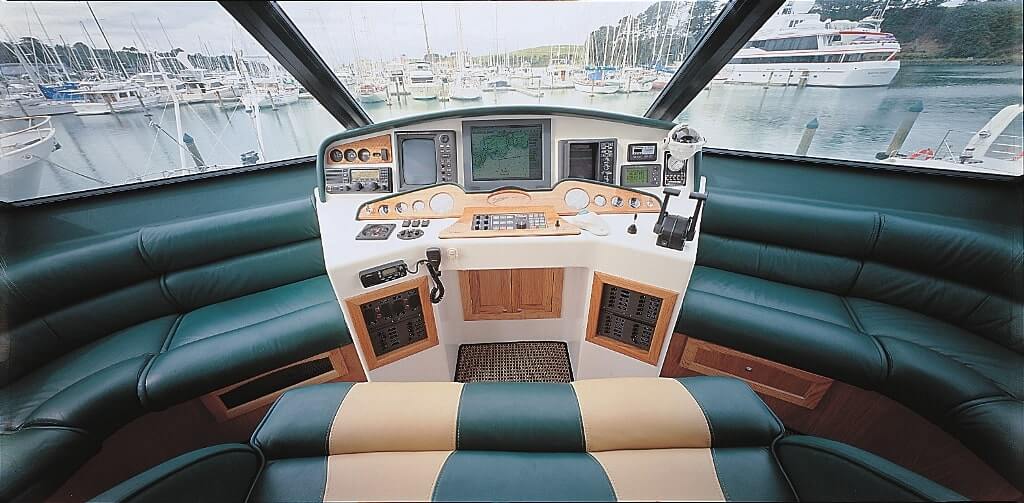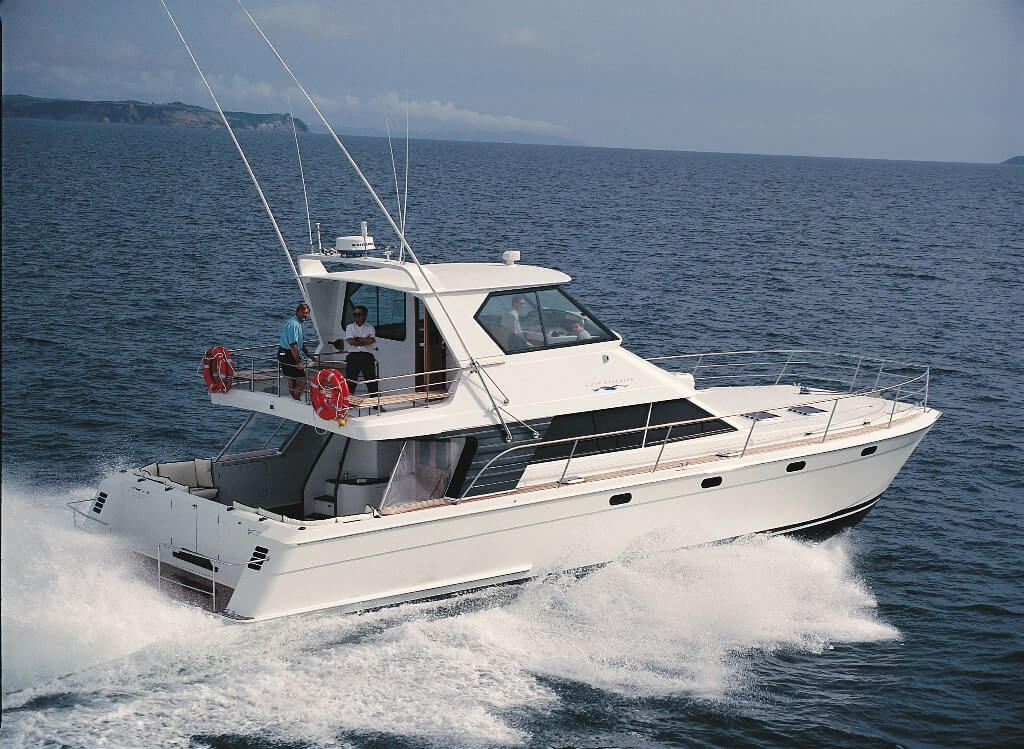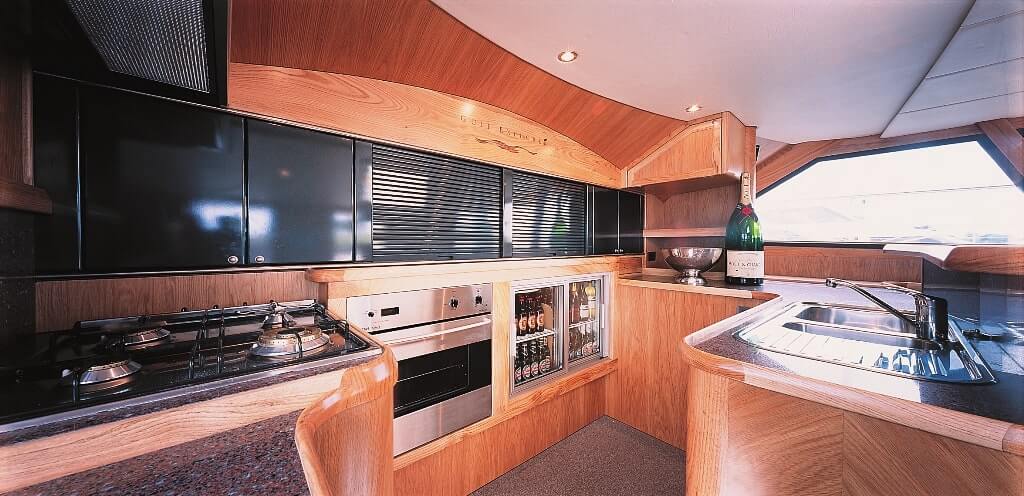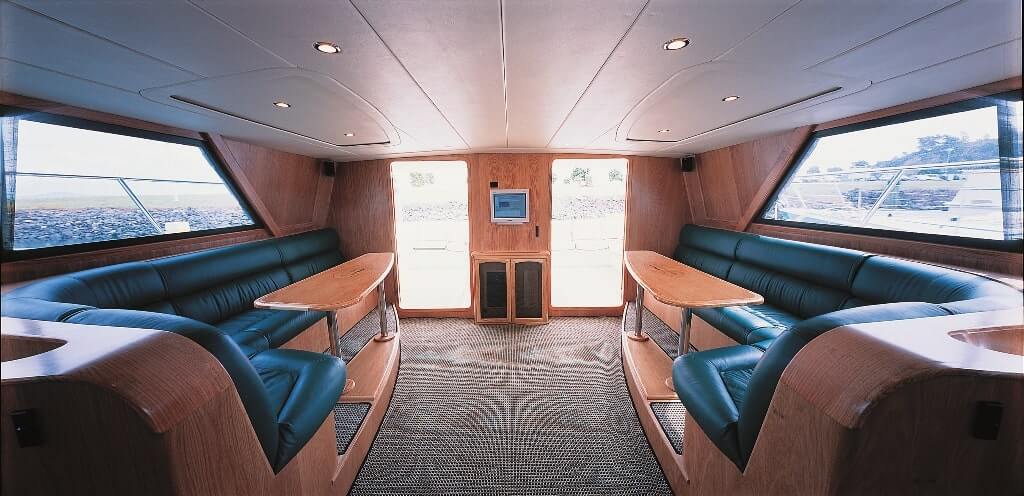EXPLORING THE GULF
Gulf Explorer is the fifth of the series of Roger Hill powercats and although the first with a heavy accent on charter use has the internal volume to be easily transformed into an exceptionally serious cruising vessel.
he commission to build Gulf Explorer went to Rotorua based Pachoud Boatbuilders, who under the leadership of Dave Pachoud had already built a number of Hill powercats and was familiar with the designers requirements.
The design is based on a well-proven hull form with four built to date, with the new Gulf Explorer, a development of that design. Although one of a series of Roger Hill powercats the basic difference with Gulf Explorer is it is set up for charter work, and features accommodation for twelve in six double size cabins.
The hulls are symmetrical and while the designer admits there is nothing wildly exciting about the hull form, he knows they are efficient and work well. The only changes to Gulf Explorer has been to widen the hulls 150mm to produce more buoyancy and enable them to carry the extra displacement. The cat was also the first with the designer’s own built-in surface drive system with offset rudders, although is a boat that lends itself to either surface drive, vee drive or conventional shafts. The next two Hill cats, (16m and 18m) being built by Pachoud Boatbuilders are being rigged with V drives.
“The owner of Gulf Explorer requested a surface drive arrangement because of expected shallow water in the mooring area and he wanted to go quick.
“While we have been having a few teething problems getting the right propeller selection we are confident that we will achieve our design speed of 30/31 knots in light trim”, said Hill.
He added that while a comfortable cruise of 20 knots is okay, in the rough water the faster this cat goes the better it likes it and generally the softer the ride.
“Crack off 10 deg to the wind and wave angle and push the throttles down. The boat just loves it”, said Hill.
The accommodation layout, all in the hulls is exactly symmetrical with each side a mirror image of the other. With six double cabins, lots of storage and the right creature comforts this boat is well set up for taking large parties away overnight and for extended cruising. However working within the parameters of the hull form, you can have just about any layout style you like.
Both the forward cabins on either side are restricted in their berth placement due to the tunnel roof height. Being raised presents no real hassles and steps are included to facilitate ease of access. Hanging lockers and deep drawers are plentiful in all the cabins and each is finished with timber walls and soft ceiling panels.

Dividing the two forward cabins from the aft double, the toilet/head compartments feature simple lacquer finishes with a walk-in shower and double doors, electric head, deadlight in the deckhead and the nice touch of timber trim on the ceiling fan.
The smaller aft cabin is also very similar to the forward two apart from the fact the double berth is lower and sits above the fuel tank. Hanging lockers and draw storage take care of all the gear and there is also access panels through to some of the plumbing and hydraulic engineering.
In previous Hill cats in this series the full pleasure boat layout has favoured two cabins in each hull and while the aft cabins stay much the same, the forward area is very flexible.
“We have done everything from huge master staterooms with private en-suites to cabins with four berths one side for the family and single staterooms opposite. Being a custom build we have the ability to give the client just about any practical accommodation layout that suits.

“The catamaran hull form allows you to be more creative in your layouts and in Gulf Explorer I have to give the builders a lot of credit for being able to visualise the final layout and get the huge accommodation requirements into perspective”, said Hill.
New Zealand Oak timber and panelling is used throughout Gulf Explorer and the intricate inlay work by Pachoud craftsman radiates in an array of areas. Thanks to direct contact with the local Rotorua sawmilling industry, Pachoud has access to some very specialist and rare native timbers, and has successfully interwoven decorative woodwork with a practical layout and whilst not ostentatious has transformed what could have been just another well finished interior into something special.
Apart from the toilet and shower areas, there are no high gloss paint finish surfaces, rather bold fabrics and light timbers interacting with rich deep pile carpet and tasteful furnishings.
There is a noticeable attention to detail throughout Gulf Explorer and it is easy to see why being based in an area not traditionally known for building big boats has not effected Pachoud’s ability to secure plenty of contracts. The 1mm thick veneer on the bulkheads for example is glued onto the structural plywood and because that’s bonded and taped to the hull, the veneer is stopped inside the bonding to eliminate any chance of swelling . This is capped with a vinyl padded pelmet over the top leading edge. Nice touch, nice finish.
Gulf Explorerʼs main saloon is roomy and spacious and uncommonly doesn’t have a forward facing screen. In charter boat mode the full width galley is very imposing and it’s design called for the elimination of the front windows. In pleasure boat mode it would be back to full windows.

The galley has a bottle fridge, large four-burner stove, oven, microwave, glass racks and even the stereo system handy to the barman. The servery top is green granite with an oak trim and a stainless steel sink unit, is surrounded with all the necessary lockers and cupboards. The main saloon layout is again open to the owners brief with some favouring rear galleys, using the forward space as a main dining area.
Guests aboard Gulf Explorer dine on raised dark green leather lounges with eye-level viewing out the side windows. Again the two matching dining tables are a masterpiece of Pachoud’s passion for inlay work with a mix of native timbers, such as rewa rewa, black maori and kauri cleverly interwoven into the design.
Look above and the recessed roof panelling with sunken lighting matches the same outline form as the tabletops.
Access to the cockpit is via a pair of double doors either side of the stairwell to the enclosed flybridge. Lockers look after storage of lifejackets, dive bottles, fishing gear, fenders and ropes and huge floor hatches on gas struts give wide access to the twin 450hp Detroit diesel engines and genset. There is a wet locker in the centre of the cockpit and double doors to the full width boarding platform. A small sink unit with granite vanity is built in alongside the stairwell and although not part of the layout in Gulf Explorer, an external head is also a popular option in this series.

The warmth of teak decks and high stainless rails carries on up the spiral staircase to the bridge, where again there is an emphasis on relaxed and comfortable living. The external bridge access is different to previous Hill cats, where an internal spiral staircase is normally designed into the rear of the saloon. The external stairway however does achieve a much nicer area upstairs with more unbroken floor space. Large leather wrap-around loungers capable of seating 20 people surround the bridge, that conveniently also has another wet bar handy. Centre stage, the helm is equipped with an extensive electronics package and all steering is done either via the autopilot or manually by toggle.
The upper aft deck is specifically designed to be large enough to provide enough seating to sit around and socialise for at least a dozen people while underway.
The inflatable tender, dinghy crane and liferaft are mounted on the foredeck, which features wide flat areas uninterrupted only by a Maxwell 3500 winch and deep lockers for fenders and ropes.

Gulf Explorer is a contemporary catamaran design that while offering numerous cabins in its charter form also lends itself perfectly to the recreational owner. The inherent handling and ride qualities of a powercat and the spaciousness set them apart from most conventional monohulls.
The Interior woods of Gulf Explorer complement the gorgeous granites in a boat with a warm and welcoming atmosphere.
TECHNICAL SPECS
- Boat Name: Gulf Explorer
- Builder: Pachoud Boats
- Designer: Roger Hill
- LOA: 16m
- Beam: 5..9m
- Draft: 1.1m
- Displacement: 18 tonnes (light)
- Max Speed: 30 knots (anticipated)
- Cruise Speed: 20 knots
- Construction: Timber/ply
- Fuel Capacity: 3000 litres
- Water Capacity: 1000 litres
- Year Launched: 1998
- Power: 2 x 6-71 Detroit




